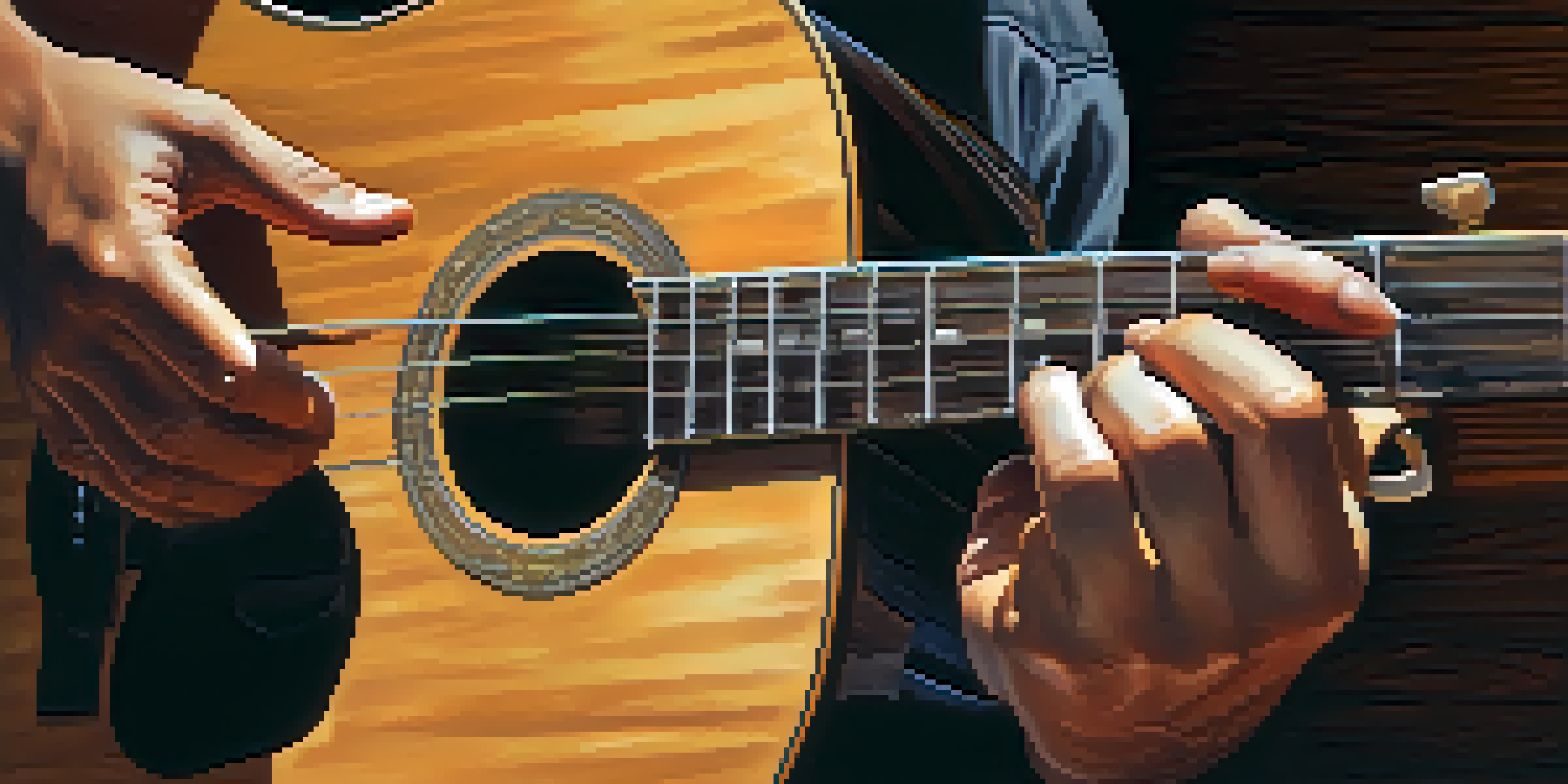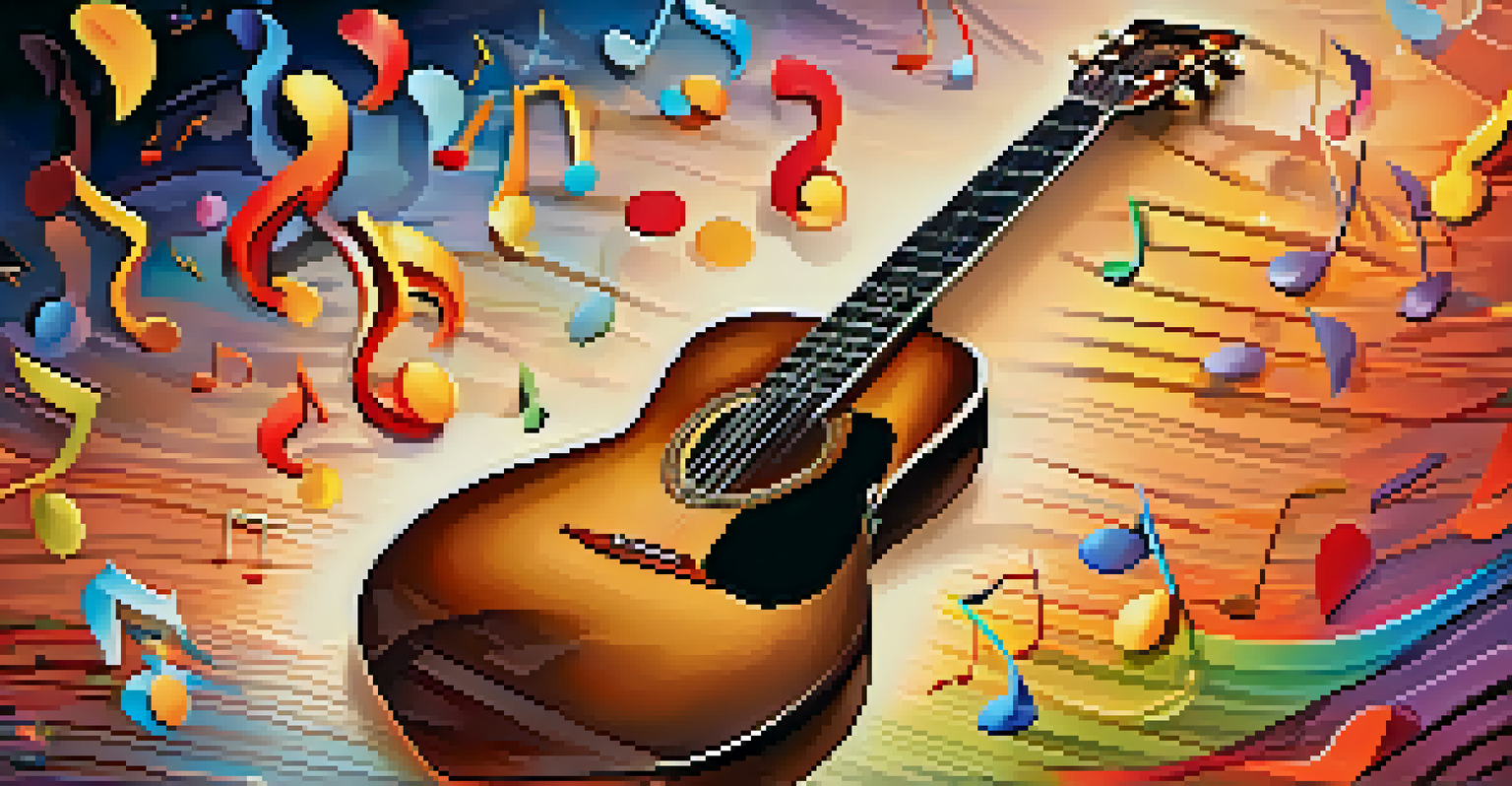Using Guitar Chords to Convey Emotions in Your Music

Understanding the Emotional Power of Guitar Chords
Guitar chords are more than just notes strummed together; they carry emotional weight. Each chord can evoke specific feelings, creating a unique atmosphere in your music. For instance, a major chord often conveys happiness or brightness, while a minor chord tends to express sadness or introspection.
Music can change the world because it can change people.
As you play, think about how different chords relate to your emotions. This connection can deepen the listener's experience, pulling them into the story you're telling. By choosing the right chords, you can guide your audience through a range of feelings, from joy to melancholy.
Ultimately, understanding this emotional power allows you to make deliberate choices in your songwriting. You'll have the ability to manipulate feelings and create a more immersive musical journey. The more you explore this, the more effectively you can communicate through your music.
Major vs. Minor Chords: The Emotional Spectrum
The distinction between major and minor chords is fundamental in music. Major chords, characterized by their bright and happy sound, can uplift a song's mood. Think of an upbeat pop song; it often features major chords to keep the energy high and the emotions positive.

On the flip side, minor chords create a more somber, reflective atmosphere. Many ballads and emotional tracks utilize minor chords to convey longing or sadness. For example, a love song might use a minor progression to express heartache, making the listener feel that raw emotion.
Chords Convey Emotion Creatively
Guitar chords not only form the foundation of music but also evoke specific feelings, allowing artists to connect deeply with their audience.
By skillfully alternating between major and minor chords, you can create a dynamic emotional landscape. This contrast not only enhances the storytelling aspect of your music but also keeps listeners engaged. It’s like painting with colors, where each chord adds depth and nuance to your emotional palette.
Using Suspended and Seventh Chords for Tension
In addition to major and minor chords, suspended and seventh chords can add layers of emotion to your music. Suspended chords create a sense of anticipation or uncertainty, often leading the listener to expect a resolution. This tension can be a powerful tool in songwriting, drawing listeners in as they wait for the chord to resolve.
The notes I handle no better than many pianists. But the pauses between the notes—ah, that is where the art resides.
Seventh chords, on the other hand, introduce a jazzy feel and complexity. They can evoke sophisticated emotions, adding richness to your sound. For instance, incorporating a dominant seventh chord can create a feeling of longing or unresolved tension, perfect for bluesy or soulful tunes.
By blending these chords into your compositions, you enhance the emotional depth of your songs. This complexity invites listeners to connect on a deeper level, making your music more impactful. Experimenting with these chords allows you to explore a wider emotional range and enrich your overall sound.
The Role of Chord Progressions in Emotional Expression
Chord progressions are the backbone of any song, and they play a crucial role in conveying emotions. A well-crafted progression can take listeners on an emotional rollercoaster. For example, the classic I-IV-V progression is bright and uplifting, while a vi-IV-I-V progression often feels nostalgic and reflective.
When creating your progressions, think about the journey you want your listeners to experience. Each transition from one chord to another can evoke different feelings, so be intentional with your choices. A simple change in the order of chords can shift the mood dramatically.
Dynamic Progressions Shape Feelings
The arrangement and progression of chords can take listeners on an emotional journey, enhancing the storytelling aspect of a song.
Ultimately, the way you arrange your chords can tell a story just as much as the lyrics. By experimenting with various progressions, you can find the perfect combination that resonates with the emotions you wish to convey. The right progression can make your music unforgettable.
Adding Dynamics and Rhythm to Enhance Emotion
While chords themselves are powerful, how you play them can amplify their emotional impact. Dynamics, or the variations in loudness, can bring life to your chords. Strumming softly during a reflective moment and then building intensity can create a compelling emotional arc.
Rhythm also plays a significant role in conveying feelings. A slower, steady rhythm might evoke calmness or sadness, while a faster, upbeat tempo can inspire joy and excitement. Think about how the rhythm of your strumming or picking patterns aligns with the emotions you want to express.
By paying attention to dynamics and rhythm, you add another layer to your musical storytelling. This attention to detail can elevate your songs, making them resonate more deeply with listeners. Ultimately, combining these elements with your chords can create a powerful emotional experience.
Exploring Alternative Chords for Unique Emotions
To create distinct emotional expressions, consider exploring alternative chords like augmented and diminished chords. These chords can introduce unexpected twists in your music. For instance, an augmented chord might evoke feelings of surprise or tension, while diminished chords can create a sense of unease or anticipation.
Using these alternative chords sparingly can help highlight key moments in your songs. For example, introducing a diminished chord before a major resolution can heighten emotional impact, making the resolution feel even more satisfying. This technique keeps listeners engaged and on their toes.
Experiment with Alternative Chords
Incorporating alternative chords can introduce unique emotions and unexpected twists, enriching the overall sound and emotional range of your music.
Experimenting with alternative chords allows you to break free from conventional patterns. This not only adds uniqueness to your music but also broadens your emotional range. You'll find new ways to connect with your audience and express complex feelings through your songwriting.
Practical Tips for Conveying Emotion with Chords
Now that you understand the emotional potential of guitar chords, here are some practical tips to harness that power in your music. Start by reflecting on the emotions you want to express and choose chords that align with those feelings. Don't be afraid to mix and match chord types to find the perfect combination for your song.
Next, consider your song's structure. How you arrange your verses, choruses, and bridges can enhance emotional delivery. For instance, you might use a softer chord progression in the verses to build intimacy and then shift to a more powerful progression in the chorus to convey a climactic moment.

Finally, always trust your instincts. If a particular chord or progression resonates with you emotionally, it’s likely to resonate with your listeners too. Embrace experimentation, and don't hesitate to revise as you go. The journey of expressing emotions through guitar chords is as rewarding as it is creative.